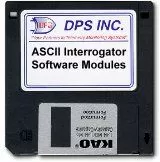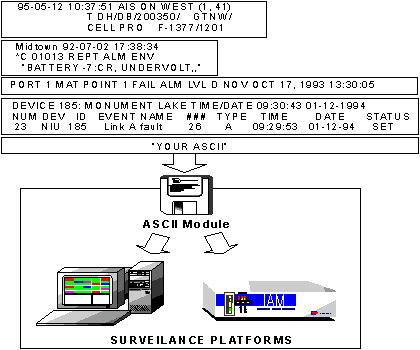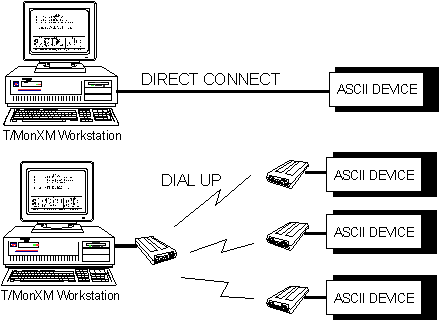Check out our White Paper Series!
A complete library of helpful advice and survival guides for every aspect of system monitoring and control.
1-800-693-0351
Have a specific question? Ask our team of expert engineers and get a specific answer!
Sign up for the next DPS Factory Training!

Whether you're new to our equipment or you've used it for years, DPS factory training is the best way to get more from your monitoring.
Reserve Your Seat Today
ASCII: The ASCII Interrogator Software modules give both the T/MonXM and IAM alarm monitoring platforms the ability to monitor any equipment that uses ASCII to report alarm or status events.
The ASCII Interrogator Software modules give both the T/MonXM and IAM alarm monitoring platforms the ability to monitor any equipment that uses ASCII to report alarm or status events.
What is ASCII?
ASCII text, for all practical purposes is plain readable English text. If you can read an alarm message that comes directly from a device via a printer or dumb terminal, then that device is considered an ASCII device. Unlike most other communication protocols which are dedicated to work over a narrow set of restrictions, ASCII itself has no such limitation. Messages can come in many different formats, lengths and syntaxes. Some devices may have cryptic alpha/numeric sequences and others might resemble a form or a columnar report.
One nice thing about ASCII is the vast amount of equipment that uses it. Many older devices report their alarms exclusively in ASCII. Even modern equipment often has at least one port that supports ASCII to some extent. It may be used on a control CRT or could be present on a printer that is dedicated to event logging.
Common types of equipment that often use ASCII are: CHANNEL BANKS, PBXs, SONNET, TL1, DIGITAL SWITCHES, LOGGING DEVICES, REMOTE ALARM EQUIPMENT (RTUs), ROUTING PLATFORMS, COMPUTERS, NETWORK ELEMENTS, DSUs, CSUs & NIUs
Alarm concentration is a major benefit of using the ASCII software modules. Instead of having ten identical devices connected to as many different terminals to report alarms, which requires a lot of space and is difficult for a person to monitor, the ASCII modules collect all the information and reports the alarms to any T/Mon user's terminal. The ASCII modules go even one step further - not only can they accept input from multiple sources, they can also accept different formats. One input device might generate alarms that appear visually different from another device, but T/Mon will process them both and generate a "Standard" alarm message. Alarm filtering can also be performed, which can dramatically reduce the amount of nuisance alarms.

The ASCII modules also provide "CRAFT" access to devices. Once T/MonXM is monitoring your devices, you have the ability to connect to any device from any T/MonXM terminal in order to perform more extensive inquiries or commands. In fact, multiple users can access different devices at the same time that the ASCII software is monitoring the remainder of the remote devices.
How do the ASCII modules work? The ASCII modules continuously look for any characters that have been received from the input port. The program then attempts to match specific portions of that data with predefined patterns (ASCII Rules). Once a rule has been found that matches the general format of a particular line or set of lines, the message is considered to be framed. At this point the ASCII processor can know with confidence the locations of other key portions of the message that identify the alarm and its status.
The ASCII modules also have the ability to periodically issue commands to ASCII devices and then process alarms based on the response. This is ideal for those devices that do not have the ability to report on change of state, but do have a status report command. Along the same lines, the ASCII modules also support device LOG-IN & LOG-OFF.
T/MonXM supports two flavors of ASCII processing, each having their own set of part numbers. The first is DIRECT CONNECT ASCII. Direct connect ASCII should be used whenever you have a device that is generally physically close, or has dedicated communication facilities that permits the unit to be directly connected to a T/MonXM port. When using this method of ASCII, each device must be connected to its own dedicated port, since ASCII is not a network protocol. Dialup ASCII is designed to work with remotes that have modems. The Dialup ASCII processor can place or accept phone calls. In most cases a single modem port has the ability to process multiple ASCII sites. For systems with multiple ASCII modem ports, some can be reserved as incoming only to facilitate critical alarm reporting. Generally, most applications will only require one of these two types of ASCII, but both software modules were designed so they can be run concurrently should the need ever arise.

The true power of ASCII processing is not realized until it is viewed in context with T/MonXM software. Once an ASCII alarm is declared it becomes a "Standard T/Mon Alarm," which may control the following functions: Local audible, 4 Level Audio / Visual relay indicators, Alarm formatting (color & content), historical functions, printer logging, optional alpha/numeric pagers, and access to responders. Other T/MonXM standard functions include: Multiple alarm windows, system security, UPS support, derived alarms, trouble logs, alarm qualification times, extended alarm messages, labeled controls, analog support, watch dog functionality, and lots of statistical real time activity indicators.
The most recent addition to the ASCII monitoring product line is the ASCII/X.25 package. This package consists of an ASCII/X.25 software module and an X.25 card. Multiple devices can be monitored over their respective PVC's & SVC's. Each logical channel can follow its own set of rules.
Customer Service
For additional information regarding the ASCII modules or our complete line of alarm monitoring hardware and software solutions, please give us a call.
| Description | Model Number |
| Direct ASCII Interrogator, single port version. | D-SK-184-10A-00 |
| Direct ASCII Interrogator, multi port version | D-SK-186-10A-00 |
| Dial Up ASCII Interrogator, single port version | D-SK-164-10A-00 |
| Dial Up ASCII Interrogator, multi port version | D-SK-163-10A-00 |
| ASCII Interrogator with X.25 Card | D-SK-183-10A-00 |